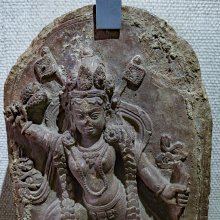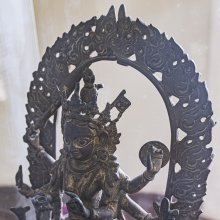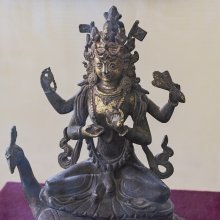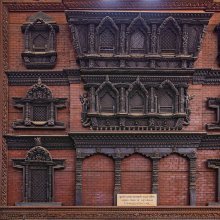Kumari, Kumārī, Kumāri: 32 definitions
Introduction:
Kumari means something in Hinduism, Sanskrit, Jainism, Prakrit, Buddhism, Pali, the history of ancient India, Marathi, Hindi, biology, Tamil. If you want to know the exact meaning, history, etymology or English translation of this term then check out the descriptions on this page. Add your comment or reference to a book if you want to contribute to this summary article.
Images (photo gallery)
(+15 more images available)
In Hinduism
Ayurveda (science of life)
Rasashastra (Alchemy and Herbo-Mineral preparations)
Source: Wisdom Library: Rasa-śāstraKumārī (कुमारी).—The name of a plant, possibly identified with Aloe indica. It is used in various alchemical processess related to mercury (rasa or liṅga), according to the Rasārṇavakalpa (11th-century work dealing with Rasaśāstra).
Nighantu (Synonyms and Characteristics of Drugs and technical terms)
Source: WorldCat: Rāj nighaṇṭu1) Kumārī (कुमारी) is another name for Vandhyākarkoṭakī, a medicinal plant identified with Momordica dioica (spiny gourd) from the Cucurbitaceae or “gourd family” of flowering plants, according to verse 3.61-63 of the 13th-century Raj Nighantu or Rājanighaṇṭu. The third chapter (guḍūcyādi-varga) of this book contains climbers and creepers (vīrudh). Together with the names Kumārī and Vandhyākarkoṭakī, there are a total of nineteen Sanskrit synonyms identified for this plant.
2) Kumārī (कुमारी) is also mentioned as a synonym for Gṛhakanyā, a medicinal plant commonly identified with Aloe vera var. chinensis Baker from the Asphodelaceae family of flowering plants, according to verse 5.47-49. The fifth chapter (parpaṭādi-varga) of this book enumerates sixty varieties of smaller plants (kṣudra-kṣupa). Together with the names Kumārī and Gṛhakanyā, there are a total of twenty-one Sanskrit synonyms identified for this plant.
Kalpa (Formulas, Drug prescriptions and other Medicinal preparations)
Source: Shodhganga: Edition translation and critical study of yogasarasamgrahaKumārī (कुमारी) refers to the medicinal plant known as “Aloe barbadensis Mill.” and is dealt with in the 15th-century Yogasārasaṅgraha (Yogasara-saṅgraha) by Vāsudeva: an unpublished Keralite work representing an Ayurvedic compendium of medicinal recipes. The Yogasārasaṃgraha [mentioning kumārī] deals with entire recipes in the route of administration, and thus deals with the knowledge of pharmacy (bhaiṣajya-kalpanā) which is a branch of pharmacology (dravyaguṇa).
Unclassified Ayurveda definitions
Source: Wisdom Library: Āyurveda and botanyKumārī (कुमारी) is another name for Mallikā (Jasminum sambac “Sambac jasmine”), from the Oleaceae family of flowering plants. The term is used throughout Ayurvedic literature such as the Carakasaṃhitā.

Āyurveda (आयुर्वेद, ayurveda) is a branch of Indian science dealing with medicine, herbalism, taxology, anatomy, surgery, alchemy and related topics. Traditional practice of Āyurveda in ancient India dates back to at least the first millenium BC. Literature is commonly written in Sanskrit using various poetic metres.
Dharmashastra (religious law)
Source: Wisdom Library: Dharma-śāstraKumārī (कुमारी) is a Sanskrit technical term referring an “unmarried daughter ”. The word is used throughout Dharmaśāstra literature such as the Manusmṛti. (See the Manubhāṣya, verse 9.131)

Dharmashastra (धर्मशास्त्र, dharmaśāstra) contains the instructions (shastra) regarding religious conduct of livelihood (dharma), ceremonies, jurisprudence (study of law) and more. It is categorized as smriti, an important and authoritative selection of books dealing with the Hindu lifestyle.
Purana and Itihasa (epic history)
Source: Wisdom Library: The Matsya-purāṇaKumārī (कुमारी) is the name of a mind-born ‘divine mother’ (mātṛ), created for the purpose of drinking the blood of the Andhaka demons, according to the Matsya-purāṇa 179.8. The Andhaka demons spawned out of every drop of blood spilled from the original Andhakāsura (Andhaka-demon). According to the Matsya-purāṇa 179.35, “Most terrible they (e.g., Kumārī) all drank the blood of those Andhakas and become exceedingly satiated.”
The Matsyapurāṇa is categorised as a Mahāpurāṇa, and was originally composed of 20,000 metrical verses, dating from the 1st-millennium BCE. The narrator is Matsya, one of the ten major avatars of Viṣṇu.
Source: Wisdom Library: Varāha-purāṇaKumārī (कुमारी).—One of the seven major rivers in Śākadvīpa, according to the Varāhapurāṇa chapter 86. Śākadvīpa is one of the seven islands (dvīpa), ruled over by Medhātithi, one of the ten sons of Priyavrata, son of Svāyambhuva Manu, who was created by Brahmā, who was in turn created by Nārāyaṇa, the unknowable all-pervasive primordial being.
The Varāhapurāṇa is categorised as a Mahāpurāṇa, and was originally composed of 24,000 metrical verses, possibly originating from before the 10th century. It is composed of two parts and Sūta is the main narrator.
Source: archive.org: Puranic Encyclopedia1) Kumārī (कुमारी).—A princess of the Kekaya kingdom. She was the mother of Pratiśravas, and wife of Bhīmasena, a King of the Puru dynasty. (Ādi Parva, Chapter 95, Verse 43).
2) Kumārī (कुमारी).—In verse 31, Chapter 23 of the Vana Parva, it is stated that certain maidens were born from the body of Skanda. They were called Kumārīs and they used to eat unborn children in the womb of their mothers.
3) Kumārī (कुमारी).—Wife of the serpent called Dhanañjaya. (Udyoga Parva, Chapter 117, Verse 17).
4) Kumārī (कुमारी).—A river in ancient India. (Bhīṣma Parva, Chapter 9, Verse 36).
5) Kumārī (कुमारी).—A river in the Śāka island. (Bhīṣma Parva, Chapter 11, Verse 32).
Source: Cologne Digital Sanskrit Dictionaries: The Purana Index1a) Kumārī (कुमारी).—A daughter of Lalitā aged nine, and trained in military art. Attacked and slew all the sons of Bhaṇḍa to the joy of the Śakti troops;1 goddess enshrined at Māyāpurī.2
1b) A R. from the Śuktimat hill.*
- * Brahmāṇḍa-purāṇa II. 16. 38; Matsya-purāṇa 163. 86.
1c) (siddhā)—A river of Śākadvīpa.*
- * Brahmāṇḍa-purāṇa II. 19. 96; Vāyu-purāṇa 45. 81; 49. 92; Viṣṇu-purāṇa II. 4. 65.
1d) Noted for Candratīrtha.*
- * Vāyu-purāṇa 77. 28.
2) Kumāri (कुमारि).—Cape Comorin, fit for śrāddha offerings.*
- * Brahmāṇḍa-purāṇa II. 16. 11; III. 13. 28.
Kumārī (कुमारी) refers to the name of a River mentioned in the Mahābhārata (cf. VI.10.34). Note: The Mahābhārata (mentioning Kumārī) is a Sanskrit epic poem consisting of 100,000 ślokas (metrical verses) and is over 2000 years old.
Kumārī also refers to the name of a Tīrtha (pilgrim’s destination) mentioned in the Mahābhārata (cf. III.86.11).

The Purana (पुराण, purāṇas) refers to Sanskrit literature preserving ancient India’s vast cultural history, including historical legends, religious ceremonies, various arts and sciences. The eighteen mahapuranas total over 400,000 shlokas (metrical couplets) and date to at least several centuries BCE.
Shaktism (Shakta philosophy)
Source: Google Books: ManthanabhairavatantramKumārī (कुमारी) is the name of the Yakṣiṇī associated with Oḍḍiyāna, one the eight Sacred Seats (pīṭha), according to the Yogakhaṇḍa (chapter 14) of the Manthānabhairavatantra, a vast sprawling work that belongs to a corpus of Tantric texts concerned with the worship of the goddess Kubjikā.
Source: Sreenivasarao's blog: Saptamatrka (part 4)Kumari or Kaumari refers to one of the seven mother-like goddesses (Matrika).—The Matrikas emerge as shaktis from out of the bodies of the gods: Kaumari from Skanda. The order of the Saptamatrka usually begins with Brahmi symbolizing creation. Then, Vaishnavi and Maheshvari. Then, Kaumari, Guru-guha, the intimate guide in the cave of one’s heart, inspires aspirations to develop and evolve.
Source: Brill: Śaivism and the Tantric Traditions (shaktism)1) Kumārī (कुमारी) refers to one of the nine Goddess to be worshiped as part of the Navarātra Tantric ritual (an autumnal festival of the warrior goddess Caṇḍikā).—From Pratipat to Navamī: daily worship by the king of nine maidens (kumārīpūjā) as nine goddesses, Kumārī, Trimūrti/Trimurtinī, Kalyāṇī, Rohiṇī, Kālikā, Caṇḍikā, Śāmbhavī, Durgā, Bhadrā.—Various 14th century sources refer to rituals involving the worship of Kumārī, for example: Caturvargacintāmaṇi, Sāmrājyalakṣmīpīṭhikā, Puruṣārthacintāmaṇi, accounts of ceremonies in Śivagaṅgai and Ramnad, Tamil Nadu (Price 1996), Portuguese traveler accounts from the Vijayanagara Empire (Stein 1983).
2) Kumārī (कुमारी) refers to a “virgin” and is used to describe Goddess Durgā, according to the King Vatsarāja’s Pūjāstuti called the Kāmasiddhistuti (also Vāmakeśvarīstuti), guiding one through the worship of the Goddess Nityā.—Accordingly, “[...] I honour Padmā, [beautiful and tender like] a lotus plant. Her eyes are lotus-like and she dwells in a bed of lotuses. Her four arms look splendid with two lotuses [in two hands] and the gestures of grace and safety [in two others]. May the virgin (kumārī) goddess Durgā annihilate my hardships, I pray. Her hands are marked by the conch and discus. She has curly locks and rides [a lion,] the king of wild animals. [...]

Shakta (शाक्त, śākta) or Shaktism (śāktism) represents a tradition of Hinduism where the Goddess (Devi) is revered and worshipped. Shakta literature includes a range of scriptures, including various Agamas and Tantras, although its roots may be traced back to the Vedas.
Natyashastra (theatrics and dramaturgy)
Source: Wisdom Library: Nāṭya-śāstraKumārī (कुमारी, “maidens”) refers to one of the classes of “women” (strī) who have dealings with the king, according to the Nāṭyaśāstra chapter 34. Accordingly, “girls who have no experience of love’s enjoyment (rati-saṃbhoga), and are quiet, devoid of rashness, modest, and bashful, are said to be maidens (kumārī)”.

Natyashastra (नाट्यशास्त्र, nāṭyaśāstra) refers to both the ancient Indian tradition (shastra) of performing arts, (natya—theatrics, drama, dance, music), as well as the name of a Sanskrit work dealing with these subjects. It also teaches the rules for composing Dramatic plays (nataka), construction and performance of Theater, and Poetic works (kavya).
Kavyashastra (science of poetry)
Source: Shodhganga: Bhismacaritam a critical studyKumārī (कुमारी) is the name of a Sanskrit metre (chandas) [defined as इ.वं.वं.वं] of the Vaṃśastha type as employed in the Bhīṣmacarita (Bhishma Charitra) which is a mahākāvya (‘epic poem’) written by Hari Narayan Dikshit.—We find twenty-six examples of Kumārī variety of Vaṃśastha metre in the Bhīṣmacarita. The example of it is verse XV.10. [...] The other examples are as follows: XV.11, XV.17, XV.32, XV.49, XVI.1, XVI.4, XVI.14, XVI.15, XVI.22, XVI.39, XVI.40, XVII.2, XVII.10, XVII.18, XVII.20, XVII.27, XVII.41, XVIII.23, XIX.4, XIX.14, XIX.22, XIX.40, XX.5, XX.20 and XX.52

Kavyashastra (काव्यशास्त्र, kāvyaśāstra) refers to the ancient Indian tradition of poetry (kavya). Canonical literature (shastra) of the includes encyclopedic manuals dealing with prosody, rhetoric and various other guidelines serving to teach the poet how to compose literature.
In Jainism
General definition (in Jainism)
Source: archive.org: Jaina YogaKumārī (कुमारी) in both Sanskrit and Prakrit refers to the plant Elettaria cardamomum Maton. This plant is classifed as ananta-kāya, or “plants that are inhabited by an infinite number of living organisms”, and therefore are abhakṣya (forbidden to consume) according to both Nemicandra (in his Pravacana-sāroddhāra v245-246) and Hemacandra (in his Yogaśāstra 3.44-46). Those plants which are classified as ananta-kāyas (e.g., kumārī) seem to be chosen because of certain morphological peculiarities such as the possession of bulbs or rhizomes orthe habit of periodically shedding their leaves; and in general theyare characterized by possibilities of vegetative reproduction.

Jainism is an Indian religion of Dharma whose doctrine revolves around harmlessness (ahimsa) towards every living being. The two major branches (Digambara and Svetambara) of Jainism stimulate self-control (or, shramana, ‘self-reliance’) and spiritual development through a path of peace for the soul to progess to the ultimate goal.
India history and geography
Source: academia.edu: Minor Chiefs and "Hero" in Ancient TamilakamKumari (“Cape”) is a name related to the historical geography and rulers of ancient Tamil Nadu, occuring in Sangam literature such as the Akanāṉūṟu and the Puṟanāṉūṟu.—Notes: ‘Comari’ of the Periplus of the Erythraean Sea, Virgin Goddess of beautiful locks lives here (Puṟam. 301, see the ‘Periplus’ cited in Sastri 2001: 59), worshipped by the Eyiṉar (Cilappatikāram 12.67).

The history of India traces the identification of countries, villages, towns and other regions of India, as well as mythology, zoology, royal dynasties, rulers, tribes, local festivities and traditions and regional languages. Ancient India enjoyed religious freedom and encourages the path of Dharma, a concept common to Buddhism, Hinduism, and Jainism.
Biology (plants and animals)
Source: Wisdom Library: Local Names of Plants and DrugsKumari in the Assamese language is the name of a plant identified with Careya arborea Roxb. from the Lecythidaceae (Brazilnut) family. For the possible medicinal usage of kumari, you can check this page for potential sources and references, although be aware that any some or none of the side-effects may not be mentioned here, wether they be harmful or beneficial to health.
Source: Google Books: CRC World Dictionary (Regional names)1) Kumari in India is the name of a plant defined with Acalypha indica in various botanical sources. This page contains potential references in Ayurveda, modern medicine, and other folk traditions or local practices It has the synonym Ricinocarpus baillonianus (Müll.Arg.) Kuntze (among others).
2) Kumari is also identified with Aloe ferox It has the synonym Pachidendron supralaeve (Haw.) Haw. (etc.).
3) Kumari is also identified with Aloe littoralis It has the synonym Aloe schinzii Baker (etc.).
4) Kumari is also identified with Aloe perryi.
5) Kumari is also identified with Aloe variegata It has the synonym Aloe variegata var. haworthii A. Berger (etc.).
6) Kumari is also identified with Amomum subulatum It has the synonym Cardamomum subulatum Kuntze (etc.).
7) Kumari is also identified with Careya arborea It has the synonym Careya arborea Roxb. & Roxb. (etc.).
8) Kumari is also identified with Dendranthema indicum It has the synonym Chrysanthemum lushanense Kitamura (etc.).
Example references for further research on medicinal uses or toxicity (see latin names for full list):
· Hortus Bengalensis (1814)
· Contributions from the Institute of Botany, National Academy of Peiping (1935)
· Journal of South African Botany (1981)
· Species Plantarum
· Parasitology Research (2008)
· Flora Cochinchinensis (1790)
If you are looking for specific details regarding Kumari, for example health benefits, extract dosage, pregnancy safety, chemical composition, side effects, diet and recipes, have a look at these references.

This sections includes definitions from the five kingdoms of living things: Animals, Plants, Fungi, Protists and Monera. It will include both the official binomial nomenclature (scientific names usually in Latin) as well as regional spellings and variants.
Languages of India and abroad
Pali-English dictionary
Source: BuddhaSasana: Concise Pali-English Dictionarykumārī : (f.) a girl; virgin.
Source: Sutta: The Pali Text Society's Pali-English DictionaryKumārī, (f.) a young girl Vin. II, 10; V, 129 (thulla°); A. III, 76; J. III, 395 (daharī k°); Pug. 66 (itthī vā k° vā).

Pali is the language of the Tipiṭaka, which is the sacred canon of Theravāda Buddhism and contains much of the Buddha’s speech. Closeley related to Sanskrit, both languages are used interchangeably between religions.
Marathi-English dictionary
Source: DDSA: The Molesworth Marathi and English Dictionarykumarī (कुमरी).—f See kumbarī.
Source: DDSA: The Aryabhusan school dictionary, Marathi-Englishkumārī (कुमारी).—f An unmarried girl, a young virgin. Aloe plant.
Marathi is an Indo-European language having over 70 million native speakers people in (predominantly) Maharashtra India. Marathi, like many other Indo-Aryan languages, evolved from early forms of Prakrit, which itself is a subset of Sanskrit, one of the most ancient languages of the world.
Sanskrit dictionary
Source: DDSA: The practical Sanskrit-English dictionaryKumārī (कुमारी).—
1) A young girl, one from 1 to 12 years old.
2) A maiden, virgin; त्रीणि वर्षाण्युदीक्षेत कुमार्यृतुमती सती (trīṇi varṣāṇyudīkṣeta kumāryṛtumatī satī) Manusmṛti 9.9;11.59; व्यावर्ततान्योपगमात्कुमारी (vyāvartatānyopagamātkumārī) R.6.69.
3) A girl or daughter in general.
4) Name of Durgā.
5) Name of several plants (Mar. koraphaḍa, karṭaulī, kāṃṭeśevaṃtī, baṭamogarā i.)
6) Name of Sītā.
7) Large cardamoms.
8) The southern extremity of the Indian peninsula (cf. the modern name Cape Comorin).
See also (synonyms): kumārikā.
Source: Cologne Digital Sanskrit Dictionaries: Edgerton Buddhist Hybrid Sanskrit DictionaryKumārī (कुमारी).—(1) , name of four female deities (mahāyakṣiṇyaḥ (Ārya-)Mañjuśrīmūlakalpa 575.10), also called Bhaginī, q.v., and noted only in (Ārya-)Mañjuśrīmūlakalpa; they have a brother called Kumāra (but ap- parently not = Kārttikeya), 45.17; 518.14; but his real name seems to have been Tumburu (otherwise known in Sanskrit as a gandharva), 537.7; 538.1, et alibi; 575.10; in 538.1; 542.9 he is called sārthavāha; otherwise they may be simply bhrātṛ-pañcamāḥ, 44.25; they are to be por- trayed standing on ships and living in the ocean, 44.25; 45.17; 575.11; they are called Kumārī 45.17; 518.14; 575.10, but Bhaginī 17.4; 44.25; 519.8 ff. The last begins a long passage dealing with them, extending to p. 546, in which repeatedly their names appear as Jayā, Vijayā, Ajitā, and Aparājitā (523.6 ff.; 528.2, 9 ff.; 537.7 ff.; 539.7, 25; 540.5; 543.3 ff.); (2) name of one specific yakṣiṇī (hardly one of the above-mentioned four): (Ārya-)Mañjuśrīmūlakalpa 567.11; 569.5; also called (yakṣa-) Kumārikā (Ārya-)Mañjuśrīmūlakalpa 569.4.
--- OR ---
Kumārī (कुमारी) or Bhaginī.—(1), q.v.
Source: Cologne Digital Sanskrit Dictionaries: Monier-Williams Sanskrit-English Dictionary1) Kumārī (कुमारी):—[from kumāra] a f. a young girl, one from ten to twelve years old, maiden, daughter, [Atharva-veda; Aitareya-brāhmaṇa] etc.
2) [v.s. ...] or (in the Tantras) any virgin up to the age of sixteen or before menstruation has commenced
3) [v.s. ...] Name of certain flags (set up along with Indra’s banner), [Varāha-mihira’s Bṛhat-saṃhitā]
4) [v.s. ...] Name of the wife of Bhīma-sena (son of Parīkṣit), [Mahābhārata i, 3796]
5) [v.s. ...] of a daughter of Vasu-deva by Rohiṇī, [Harivaṃśa 1952]
6) [v.s. ...] of Sītā (Rāma’s wife), [cf. Lexicographers, esp. such as amarasiṃha, halāyudha, hemacandra, etc.]
7) [v.s. ...] of the goddess Durgā, [Harivaṃśa 9425]
8) [v.s. ...] of Dākṣāyaṇī (in Māyā-purī), [Matsya-purāṇa]
9) [v.s. ...] of a metre (a kind of Śakvarī, consisting of four lines of sixteen syllables each)
10) [v.s. ...] the bird commonly called Śyāmā, [cf. Lexicographers, esp. such as amarasiṃha, halāyudha, hemacandra, etc.]
11) [v.s. ...] the plant Aloe perfoliata, [cf. Lexicographers, esp. such as amarasiṃha, halāyudha, hemacandra, etc.]
12) [v.s. ...] the plant Clitoria ternatea (= a-parājitā), [cf. Lexicographers, esp. such as amarasiṃha, halāyudha, hemacandra, etc.]
13) [v.s. ...] the plant Jasminum Sambac, [cf. Lexicographers, esp. such as amarasiṃha, halāyudha, hemacandra, etc.]
14) [v.s. ...] the plant commonly called bandhyā-karkoṭakī, [cf. Lexicographers, esp. such as amarasiṃha, halāyudha, hemacandra, etc.]
15) [v.s. ...] the blossom of the plants Taruṇī and Modinī, [cf. Lexicographers, esp. such as amarasiṃha, halāyudha, hemacandra, etc.]
16) [v.s. ...] great cardamoms, [cf. Lexicographers, esp. such as amarasiṃha, halāyudha, hemacandra, etc.]
17) [v.s. ...] the most southerly of the nine portions of the known continent or of Jambū-dvīpa (the southern extremity of the peninsula, whence the modern name Cape Comorin [Kumārī]), [Horace H. Wilson]
18) [v.s. ...] the central part of the universe (according to Hindū geography, Jambū-dvīpa or India), [cf. Lexicographers, esp. such as amarasiṃha, halāyudha, hemacandra, etc.]
19) [v.s. ...] Name of a river flowing from the mountain Śuktimat, [Mahābhārata; Harivaṃśa; Viṣṇu-purāṇa]
20) [v.s. ...] of another river, [Hemādri’s Caturvarga-cintāmaṇi]
21) [v.s. ...] (when a name is given to a pupil to indicate his attachment to any particular master, kumārī may be prefixed to denote that the pupil’s object is to gain the affections of the master’s daughter e.g. kumārī-dākṣa q.v. sub voce kumārī)
22) Kumāri (कुमारि):—[from kumāra] (shortened for rī q.v.; cf. [Pāṇini 6-3, 63]).
23) Kumārī (कुमारी):—[from kumāra] b f. of ra q.v.
24) [v.s. ...] mfn. desirous of a daughter, [Pāṇini 1-4, 3; Patañjali]
Source: DDSA: Paia-sadda-mahannavo; a comprehensive Prakrit Hindi dictionary (S)Kumārī (कुमारी) in the Sanskrit language is related to the Prakrit words: Kuṃārī, Kumārī.
[Sanskrit to German]
Sanskrit, also spelled संस्कृतम् (saṃskṛtam), is an ancient language of India commonly seen as the grandmother of the Indo-European language family (even English!). Closely allied with Prakrit and Pali, Sanskrit is more exhaustive in both grammar and terms and has the most extensive collection of literature in the world, greatly surpassing its sister-languages Greek and Latin.
Hindi dictionary
Source: DDSA: A practical Hindi-English dictionaryKumārī (कुमारी):—(a) virgin, maiden; unmarried; (nf) a virgin/maiden; cape; —[kanyā] a virgin girl.
...
Prakrit-English dictionary
Source: DDSA: Paia-sadda-mahannavo; a comprehensive Prakrit Hindi dictionary1) Kuṃārī (कुंआरी) in the Prakrit language is related to the Sanskrit word: Kumārī.
2) Kumārī (कुमारी) also relates to the Sanskrit word: Kumārī.
3) Kumārī (कुमारी) also relates to the Sanskrit word: Kumārī.
Prakrit is an ancient language closely associated with both Pali and Sanskrit. Jain literature is often composed in this language or sub-dialects, such as the Agamas and their commentaries which are written in Ardhamagadhi and Maharashtri Prakrit. The earliest extant texts can be dated to as early as the 4th century BCE although core portions might be older.
Kannada-English dictionary
Source: Alar: Kannada-English corpusKumari (ಕುಮರಿ):—
1) [noun] a tract of land cleared of forest or trees.
2) [noun] a tract of land that is unable to produce vegetation; a barren land.
--- OR ---
Kumari (ಕುಮರಿ):—
1) [noun] a female off-spring; a daughter.
2) [noun] a girl or woman who has never had sexual intercourse; a virgin.
--- OR ---
Kumāri (ಕುಮಾರಿ):—
1) [noun] a female off-spring; a daughter.
2) [noun] a girl or woman who has never had sexual intercourse; a virgin.
3) [noun] a girl before her age of puberty.
4) [noun] a respectful mode of addressing a girl or woman who is not married.
5) [noun] the plant Jasminum grandiflorum ( = J. officinale) of Oleaceae family; Arabian jasmine.
6) [noun] its flower.
7) [noun] the plant Aloe perfoliata of Liliaceae family.
8) [noun] the plant Rosa alba of Rosaceae family.
9) [noun] the tree Diospyros eregrina ( = d. embryopteris, = D. glutenifera) of Ebenaceae family; river ebony.
10) [noun] Durgā, the formidable form of Pārvati.
Kannada is a Dravidian language (as opposed to the Indo-European language family) mainly spoken in the southwestern region of India.
Tamil dictionary
Source: DDSA: University of Madras: Tamil LexiconKumari (குமரி) noun < kumārī.
1. Virgin, maid; கன்னி. குமரிமணஞ் செய்துகொண்டு [kanni. kumarimanagn seythugondu] (நாலாயிர திவ்யப்பிரபந்தம் பெரிய.ாழ். [nalayira thivyappirapandam periyazh.] 3, 8, 3).
2. Grown-up unmarried girl; பருவமடைந்த பெண். [paruvamadaintha pen.]
3. Daughter; புதல்வி. தக்கனீன்ற . . . குமரியான [puthalvi. thakkaninra . . . kumariyana] (கந்தபு. பாயி. [kanthapu. payi.] 57).
4. Durgā துர்க்கை. விழிநுதற் குமரி [thurkkai. vizhinuthar kumari] (சிலப்பதிகாரம் அரும்பதவுரை [silappathigaram arumbathavurai] 11, 214).
5. A river. See குமரியாறு. வடவேங்கடந் தென் குமரி (தொல்காப்பியப் பாயிரவிருத்தி). [kumariyaru. vadavengadan then kumari (tholkappiyap payiraviruthi).]
6. Cape Comorin; குமரி முனை. [kumari munai.]
7. Sacred waters at Cape Comorin; கன் னியாகுமரி தீர்த்தம். தென்றிசைக்குமரி யாடியவருவோள் [kan niyagumari thirtham. thenrisaikkumari yadiyavaruvol] (மணிமேகலை [manimegalai] 13, 7.)
8. Perpetual youthhood; uncorrupt, unspoilt condition; அழிவின்மை. குமரிக் கூட்டிற் கொழும் பல்லுணவு [azhivinmai. kumarig kuttir kozhum pallunavu] (சிலப்பதிகாரம் அரும்பதவுரை [silappathigaram arumbathavurai] 10, 123).
9. Aloe; கற்றாழை. (திவா.) [karrazhai. (thiva.)]
--- OR ---
Kumari (குமரி) noun Cultivation in hills; மலைநிலத்துச் செய்யும் விவசாயம். [malainilathus seyyum vivasayam.]
--- OR ---
Kumāri (குமாரி) noun < kumārī.
1. Daughter; புதல்வி. [puthalvi.]
2. Kāḷī; காளி. [kali.] (W.)
3. Woman of perpetual youth, ever in the prime of life; அழியா இளமையினள். அமர்செய் கயற்கட் குமாரியைக் காக்க [azhiya ilamaiyinal. amarsey kayarkad kumariyaig kakka] (மீனாட்சியம்மை பிள்ளைத் காப்பு. [minadsiyammai pillaith kappu.] 4).
4. Solvent of gold; சுவர்ணபேதி. [suvarnapethi.] (W.)
Tamil is an ancient language of India from the Dravidian family spoken by roughly 250 million people mainly in southern India and Sri Lanka.
See also (Relevant definitions)
Starts with (+51): Kumari-sahasa, Kumaribetta, Kumaribhaga, Kumaribhava, Kumaribhushira, Kumaribhuta Vagga, Kumariccerppan, Kumariccura, Kumaricivan, Kumarida, Kumaridaksha, Kumaridara, Kumaridatta, Kumaridvipa, Kumarihamilla, Kumarihridaya, Kumarika, Kumarikakhanda, Kumarikakshetra, Kumarikalpa.
Ends with (+25): Adikumari, Alamkumari, Arasukumari, Atirajakumari, Bal-kumari, Dikkumari, Dutthakumari, Ekkiyakumari, Geevkumari, Gheekumari, Ghekumaari, Ghikumari, Ghirtakumari, Ghiukumari, Ghrit-kumari, Ghritakumari, Ghritkumari, Ghrytakumari, Ghue kumari, Ghyu-kumari.
Full-text (+239): Kumarika, Ghritakumari, Alamkumari, Kumaritama, Kumarida, Kanyakumari, Nandopanandasamjna, Kumaripuja, Kumara, Karnakumari, Kumariputra, Kumarishvashura, Upanandasamjna, Grihakanya, Grihakumari, Kumaripura, Kumaari bettha, Kumaritara, Kumaari poliki, Kumaridatta.
Relevant text
Search found 72 books and stories containing Kumari, Kumārī, Kumāri, Kumarī, Kuṃārī, Kumaari; (plurals include: Kumaris, Kumārīs, Kumāris, Kumarīs, Kuṃārīs, Kumaaris). You can also click to the full overview containing English textual excerpts. Below are direct links for the most relevant articles:
Brihad Bhagavatamrita (commentary) (by Śrī Śrīmad Bhaktivedānta Nārāyana Gosvāmī Mahārāja)
Verse 1.7.104-106 < [Chapter 7 - Pūrṇa (pinnacle of excellent devotees)]
The Devi Bhagavata Purana (by Swami Vijñanananda)
Chapter 27 - On the virgins fit to be worshipped and the Glory of the Devī < [Book 3]
Chapter 26 - On the narration of what are to be done in the Navarātri < [Book 3]
Chapter 30 - On the birth of Gaurī, the seats of the Deity, and the distraction of Śiva < [Book 7]
Diaspora of Bhuta (Daiva) worshipping cult—India and Indonesia (by Shilpa V. Sonawane)
Part 11 - Lumeria (Kumari Kandam) < [Chapter 4 - Inter-Disciplinary Analysis]
Part 14 - Contact To South India: < [Chapter 4 - Inter-Disciplinary Analysis]
Dhammapada (Illustrated) (by Ven. Weagoda Sarada Maha Thero)
Verse 48 - The Story of Patipūjikā Kumāri < [Chapter 4 - Puppha Vagga (Flowers)]
Cidgaganacandrika (study) (by S. Mahalakshmi)
Verse 195 [Bimba and Pratibimba] < [Chapter 4 - Fourth Vimarśa]
Amaravati Art in the Context of Andhra Archaeology (by Sreyashi Ray chowdhuri)
Epigraphs from Amarāvatī (e) Administrative and Bureaucratic < [Chapter 4 - Survival of Amarāvatī in the Context of Andhra Art]
Epigraphs from Amarāvatī (i) Monks and Nuns < [Chapter 4 - Survival of Amarāvatī in the Context of Andhra Art]
Related products
(+47 more products available)











